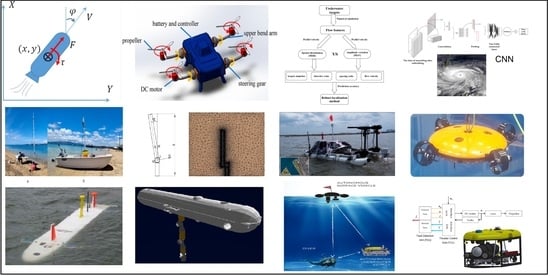Intelligent Marine Robotics Modelling, Simulation and Applications
Author Contributions
Funding
Acknowledgments
Conflicts of Interest
References
- Shen, H.; Iorio, J.; Li, N. Sliding Mode Control in Backstepping Framework for a Class of Nonlinear Systems. J. Mar. Sci. Eng. 2019, 7, 452. [Google Scholar] [CrossRef] [Green Version]
- Chen, Y.; Liu, Y.; Meng, Y.; Yu, S.; Zhuang, Y. System Modeling and Simulation of an Unmanned Aerial Underwater Vehicle. J. Mar. Sci. Eng. 2019, 7, 444. [Google Scholar] [CrossRef] [Green Version]
- Lin, X.; Wu, J.; Qin, Q. A Novel Obstacle Localization Method for an Underwater Robot Based on the Flow Field. J. Mar. Sci. Eng. 2019, 7, 437. [Google Scholar] [CrossRef] [Green Version]
- Yu, J.; Zhao, Q.; Chin, C.S. Extracting Typhoon Disaster Information from VGI Based on Machine Learning. J. Mar. Sci. Eng. 2019, 7, 318. [Google Scholar] [CrossRef] [Green Version]
- Yamamoto, B.; Wong, A.; Agcanas, P.J.; Jones, K.; Gaspar, D.; Andrade, R.; Trimble, A.Z. Received Signal Strength Indication (RSSI) of 2.4 GHz and 5 GHz Wireless Local Area Network Systems Projected over Land and Sea for Near-Shore Maritime Robot Operations. J. Mar. Sci. Eng. 2019, 7, 290. [Google Scholar] [CrossRef] [Green Version]
- Zhang, M.; Liu, X.; Tian, Y. Modeling Analysis and Simulation of Viscous Hydrodynamic Model of Single-DOF Manipulator. J. Mar. Sci. Eng. 2019, 7, 261. [Google Scholar] [CrossRef] [Green Version]
- Fan, J.; Li, Y.; Liao, Y.; Jiang, W.; Wang, L.; Jia, Q.; Wu, H. Second Path Planning for Unmanned Surface Vehicle Considering the Constraint of Motion Performance. J. Mar. Sci. Eng. 2019, 7, 104. [Google Scholar] [CrossRef] [Green Version]
- Li, J.-H.; Kim, M.-G.; Kang, H.; Lee, M.-J.; Cho, G.R. UUV Simulation Modeling and its Control Method: Simulation and Experimental Studies. J. Mar. Sci. Eng. 2019, 7, 89. [Google Scholar] [CrossRef] [Green Version]
- Sands, T.; Bollino, K.; Kaminer, I.; Healey, A. Autonomous Minimum Safe Distance Maintenance from Submersed Obstacles in Ocean Currents. J. Mar. Sci. Eng. 2018, 6, 98. [Google Scholar] [CrossRef] [Green Version]
- Barbalata, C.; Dunnigan, M.W.; Petillot, Y. Coupled and Decoupled Force/Motion Controllers for an Underwater Vehicle-Manipulator System. J. Mar. Sci. Eng. 2018, 6, 96. [Google Scholar] [CrossRef] [Green Version]
- Chiarella, D.; Bibuli, M.; Bruzzone, G.; Caccia, M.; Ranieri, A.; Zereik, E.; Marconi, L.; Cutugno, P. A Novel Gesture-Based Language for Underwater Human–Robot Interaction. J. Mar. Sci. Eng. 2018, 6, 91. [Google Scholar] [CrossRef] [Green Version]
- Capocci, R.; Omerdic, E.; Dooly, G.; Toal, D. Fault-Tolerant Control for ROVs Using Control Reallocation and Power Isolation. J. Mar. Sci. Eng. 2018, 6, 40. [Google Scholar] [CrossRef] [Green Version]
© 2020 by the authors. Licensee MDPI, Basel, Switzerland. This article is an open access article distributed under the terms and conditions of the Creative Commons Attribution (CC BY) license (http://creativecommons.org/licenses/by/4.0/).
Share and Cite
Chin, C.S.; Cui, R. Intelligent Marine Robotics Modelling, Simulation and Applications. J. Mar. Sci. Eng. 2020, 8, 383. https://doi.org/10.3390/jmse8060383
Chin CS, Cui R. Intelligent Marine Robotics Modelling, Simulation and Applications. Journal of Marine Science and Engineering. 2020; 8(6):383. https://doi.org/10.3390/jmse8060383
Chicago/Turabian StyleChin, Cheng Siong, and Rongxin Cui. 2020. "Intelligent Marine Robotics Modelling, Simulation and Applications" Journal of Marine Science and Engineering 8, no. 6: 383. https://doi.org/10.3390/jmse8060383






